#Advanced Engine Control Units
Explore tagged Tumblr posts
Text
Unleashing Power: A Guide to Increasing Engine Performance in Your Vehicle
Dive into the world of turbochargers and intercoolers, where engineering brilliance meets automotive performance. Uncover the secrets behind maximizing engine power and efficiency with this comprehensive guide. Keywords: turbocharger, intercooler, engine performance, automotive engineering, forced induction, combustion efficiency, turbocharging technology, intercooling advancements. In the realm…

View On WordPress
#Advanced Engine Control Units#Aftermarket Modifications#automotive#Automotive engineering#car-culture#cars#Combustion Efficiency#Engine performance#Engine Performance Upgrades#Forced Induction#Good Old Bandit#Gud Ol Bandit#High-Performance Camshafts#Increased Horsepower#Intercooler#Intercooling Advancements#News#Nitrous Oxide Systems#Performance Exhaust Systems#Sanjay K Mohindroo#Sanjay Kumar Mohindroo#Sanjay Mohindroo#technology#Turbocharger#Turbochargers And Superchargers#Turbocharging Technology#Unleashing Vehicle Power#Vehicle Tuning Guide
0 notes
Text






Stobotnik E.Y.E: Divine Cybermancy AU.
ROBOTNIK: Orus, Psyker. Colonel of The Para-psychic Army. Master, War conjuror. Ex-Nemesis. Joined The Federation shortly after the Orus-human alliance was formed. Known participant of 96 years' war against The Unknown Force. A brilliant engineer that created several advanced weapons for The Para-psychic Army. Pursues absolute power in secret and does his own thing behind The Federation's back. Known for his extremely low mental balance and high PSI-powers. Cybertech: Cyber Brain, Cyber Eyes, Cyber Arms, Cyber Weapon Interface, Cyber Neuronal Interface, PSI Decuplator, FireWall.
STONE: Human, Telepath. Captain in The Para-psychic Army under Robotnik's command. Ex-CCMC, The Federation's special unit of megacorp investigation and intervention. Was reassigned to The Para-psychic Army thanks to his telepathic powers. Extraordinarily high mental balance. Cybertech: Cyber Brain, Cyber Eyes, Cyber Arms, Adrenaline Pumper, Cyber Weapon Interface, Wired Reflex, Nervous Control, Cyber Armored Skull, Muscular Control, Cyber Armored Torso, FireWall, Cyber Legs.




#sonic the hedgehog#stobotnik#sonic fanart#agent stone#ivo robotnik#dr robotnik#jimbotnik#sonic movie universe#eye divine cybermancy#e.y.e divine cybermancy#stobotnik cybermancy au
489 notes
·
View notes
Text
Tony Stark’s achievements
Childhood:

“Brilliant and unique mind”
At age 4 built his first circuit board
At age 6 built his first engine
Cracked the Pentagon’s firewall in high school on a dare
Went to college at 14
Built cool smart robots (Dum-E and U) when he was a teen
At 17 graduated summa cum laude from MIT
Polyglot
Before Afghanistan:

“Da Vinci of our time”
Became an owner and CEO of Stark Industries at 21
Successfully ran the company for decades
Advanced the world of technology, not only in weaponry and robotics but also:
created advanced AI J.A.R.V.I.S.
created holographic interface technology
created repulsor technology
Participated in charity
In and after Afghanistan:

“I’m sorry, I’m not Tony Stark”
Survived an open-heart surgery in a cave, without general anesthesia
Lived with, in fact, a debilitating wound, shrapnel, and a huge and dangerous technological device in his body for years and was willing and capable of doing not only his usual work but also being a superhero and doing all these next things...
Did not give up under torture and fought with his captors
Invented and built a miniaturized Arc Reactor, in a cave, with a box of scraps
Invented and built Iron Man armor, in the same cave, with the same box of scraps
Escaped from captivity by himself (with help from Yinsen, but without any armed assistance)
Became an expert in piloting and driving
Saved people in Gulmira
Saved a USAF pilot
Probably the best hacker in the world, was able to easily hack networks of the Pentagon, US government, AIM, and SHIELD
Fought with Iron Monger after nearly died. Defeated him and saved many lives. Was ready to die for that
Built many more different Iron Man armors
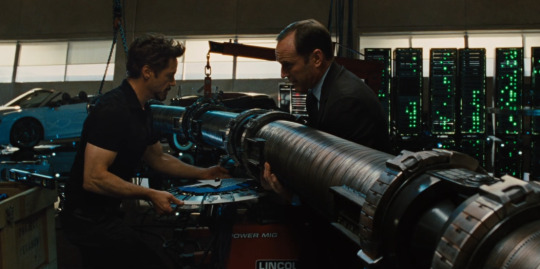
Fought terrorists between IM and IM2 (IM2 tie-in comics)
Saved a submarine crew (IM2 - newspapers in Vanko’s home)
Saved a woman from a fire (IM2 - newspapers in Vanko’s home)
“Stabilized East-West relations” (IM2 - newspapers in Vanko’s home), so the world was “enjoying its longest period of uninterrupted peace in years”
Organized Stark Expo
Was able to keep Iron Man armor in his safe hands despite the government’s and HYDRA’s attempts to take it for themselves
Defeated Ivan Vanko in Monaco
(Re)Discovered a new element
Synthesized it, by building a particle accelerator, at home
Revolutionized energy industry and science. Gave clean energy to the world
Defeated Vanko in New York with Rhodey, Natasha, and Pepper and saved many lives again
Saved Peter Parker (IM2)
Made it so that the Abomination would not leave prison and join the Avengers

Built Stark/Avengers Tower powered by Arc Reactor technology
Saved Steve Rogers and many civilians in Germany from Loki
Was able to fight with Thor on equal terms
Biggest brain on Earth, arguably - in the Universe:
best scientist on the team, in SHIELD, on Earth, in the Universe
expert in nuclear, particle, and quantum physics
was able to learn very quickly – became an expert in thermonuclear astrophysics in one night
Successfully tracked Tesseract by its gamma radiation with Bruce
Saved Helicarrier with the Avengers and SHIELD agents on board, almost died
Saved Rogers from a merc right after that
Fought with Chitauri, killed many of them, saved a lot of people
Was able to blow up a Leviathan by himself
Saved New York City by redirecting a nuke to the wormhole
Saved the world by destroying Thanos’ Chitauri army, almost died again
Founded The United States Department of Damage Control to clean up after battles
Rebuilt Stark Tower into Avengers Tower and gave each team member their own quarters

One of the best biologists and biomedical engineers on Earth, even if it’s not his main area of expertise:
helped Maya with Extremis back in 1999, because knew more in her own field, and even didn’t remember that
was head hunted by Aldrich Killian to work on Extremis with/instead of Maya, who was the leading expert in tissue regeneration
improved and stabilized Extremis, so it became safe regenerative technology, and with it…
cured Pepper
healed extensive injuries in his chest
invented and implanted devices for remote control of his suits (into his forearm in IM3, and most probably into his brain for Mark L armor in Infinity War)
invented build-in diagnostic system in his suits
Invented many devices for protection purposes (ex. bomb disposal)
A capable detective. Figured out the cause of explosions in IM3 on his own
Saved Pepper instead of himself by putting Mark 42 on her during the attack on his Malibu mansion
Survived the attack with a barely working prototype suit. Shot down a helicopter with a piano
Was able to fight with enhanced fire-breathing regenerating terrorists without armor and weapons in Rose Hill. In handcuffs
Knowledgeable and skilled in medicine:
saved a kid with his arc reactor in a deleted scene from IM3, selflessly pulling it out of his chest and performing defibrillation under electric shocks
knew how to recognize hyperglycemia when Harley was eating 3rd bawl of candies
closed his wound in Infinity War with nanoparticles
performed first-aid on Bruce after his snap
Built a lot of stuff from random things he bought in a store for the assault on the Mandarin's mansion. In a motel
Successfully stormed the Mandarin's mansion full of armed and huge security guys with dogs. Alone. Without his armor
Successfully escaped captivity in the Mandarin's mansion with just a few pieces of armor on
Saved all the people who fell from the Air Force One
Stormed Roxxon Norco ship with Rhodey, without a suit. With one handgun
Saved the US president
Defeated Killian and his Extremis-enhanced terrorists, saved many lives
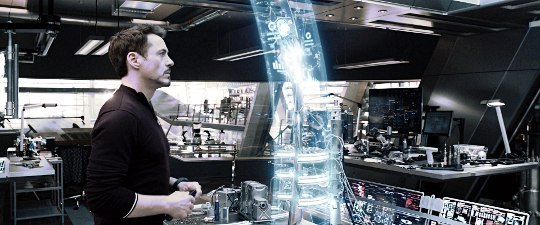
Built quinjets
Created Iron Legion
Became the benefactor of the Avengers, provided them with everything, was a combatant, and also the team’s pilot, hacker, engineer, medic, and scientist
As an Avenger saved many lives on missions, including destroying the rest of HYDRA in AoU
With Bruce’s help created Veronica and Hulkbuster suit
Defeated a rogue Iron Legionnaire with a fork
In contrast to other team members was able to function after Wanda played with his mind
Defeated mad Hulk. Saved a lot of lives in Johannesburg
Easily hacked nuclear codes in Nexus and found J.A.R.V.I.S. “in the world’s biggest haystack”
Created advanced AI F.R.I.D.A.Y.
Many advanced AIs
Created Vision
With the Avengers defeated Ultron and his army
Evacuated people who were left in Sokovia
Saved a falling evacuation shuttle with people on it
Together with Thor saved Earth by destroying the falling Sokovia
Rebuilt Stark Compound into Avengers Compound for the team in Upstate New York

Invented several medical devices, including leg braces, blood toxicity detector
Sponsored the development of technology for psychotherapy (B.A.R.F.). Prevented it from being used for harm
Funded all the students’ projects at MIT
Did everything possible to legally, politically, and physically protect the team before, during, and after the Civil War
Was able to disarm Winter Soldier without a suit, with only one armored glove
Figured out Spider-Man’s identity
Created Spider-Man’s suits
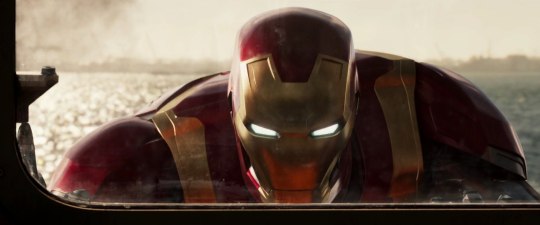
Mentored, sponsored, and looked after Peter Parker
Saved Peter Parker (SMH). Twice
Saved the ferry from sinking
Invented nanoparticles

“Earth’s best defender”
Went to space to save Peter, Strange and bring back Time Stone
Saved Peter Parker (IW)
Saved Strange on the Donut spaceship. Killed Ebony Maw
Cloak of Levitation chose him as his second favorite (deleted scene with Tony wearing Levi and Strange in Mark L)
Was respected by Thanos himself
Withstood when Thanos hit him with a moon
Fought Thanos, made him bleed, kept fighting even without armor
Survived a severe injury thanks to his own invention
Was able to function, tried to fix Benatar, and return home while injured and ill with an infected wound
Built a lab for Bruce and helped him to become one with Hulk (combine the best of both worlds)
Became an amazing dad
Became an expert in time travel physics
Discovered/invented (controlled) Time travel
Built a time machine
Went on Time Heist and stole Tesseract from a guarded military base
Created his own Infinity Gauntlet
Thus brought half of the universe back to existence (Bruce snapped and partially sacrificed his health, but nothing would be possible without Tony)
Saved Bruce’s arm by providing emergency medical care
Fought with Thanos again and…
Saved the whole Universe

#tony stark#iron man#mcu#marvel#the avengers#avengers endgame#captain america civil war#avengers age of ultron#iron man 2#iron man 3#spider man homecoming#avengers infinity war
953 notes
·
View notes
Text
Finally ready to start showing off the project we've been working on for a few weeks.
TRAIN PUZZLE (dot exe) (title pending)

me and @msasterisk are working on a switching puzzle game set on slimegirl astronaut Eaurp Guz's homeworld. You operate an Advanced Steam switcher to move cars around. The prototype implements a single level, a model railroad Inglenook layout, but there will be other original levels as well.
MsAsterisk has done all of the programming and game engine work, I've done the game design and art assets.
more screenshots and development photos below the cut:


Until the last couple of days, the game has used plain colored boxes for its cars. The first playable version, shown here, was just a pixel art train toy, with no actual game mechanics, but with an external list randomizer you could still run the inglenook game.
The physics was apparently a monumental undertaking to get working, but now it works great!

i don't remember what this was about. Truncated the vertices to the unit cube or something.

@thefallencomet's playtesting of the first prototype revealed a severe bug with couplers where switching cars coupled at a distance between three tracks at once would completely break physics. MsAsterisk fixed it by simply breaking couplers when they're too far apart.

car concept art

u.i. concept art. The tracks are bonafide pixel art here, but they've since been replaced with all 3D assets. The loco here is a pixelated render done in blender of the advanced steam tank engine model that i made about a month ago.

control stand model, WIP. We're not sure if we're going to go for this kind of detailed control stand. Why does a steam engine use a control stand that would look more at home on an EMD diesel? It's the magic of Advanced Steam Technology! The actual engine is controlled with actuators and microcontrollers, they're merely operated from the safety of the control cabin. The gauges are for brake cylinder, boiler pressure, steam chest, and speedometer--but no promises about whether these will be functional.



and finally, portraits of the engine crew
More to come as the game continues development.
#Train Puzzle#train#advanced steam#mellanoid slime worldbuilding#shunting#switching#switching puzzle#shunting puzzle#puzzle game#indie game#game dev#video game#train game#steam train#boxcar
119 notes
·
View notes
Note
Could I request a Kenji x Reader where the reader is an Ailen who is very much stranded on Earth and on The run from the KDF who wants access to their tech
Among the Stars I
Kenji Sato x Alien!Reader
Word Count: 1,766
Genre/Warning: Falling in Love, Friends to Lovers, Slow Burn
Author’s Note: To me, reader is an alien in the sense that she is a foreigner to this planet; how she looks is up to you. Takes place after Emi. AND I THINK AOSHIMA DESERVES RECOGNITION LIKE 🫢 AIN’T HE HOT TOO?????
MASTERLIST

The stars twinkled in the dark expanse of space as you navigated through the cosmos. This wasn’t the first time you traversed through the void. In fact, you were a professional at this.
Being one of the respected astrophysicists of your planet, you have always been one sent on space voyages. Your mission was simple, something you were good at, so what could possibly go wrong?
At least that’s what you thought a few moments ago.
"Engine malfunction detected. Immediate landing required.”
As if the flashing red lights and blaring alarms weren’t enough, the onboard AI wouldn’t shut up either, all of them adding up to the panic in your already pounding heart.
“Engine failure. Emergency landing procedure initiated.”
Your struggle to regain control was hopeless. Assessing your options, Earth was the nearest habitable planet. With no time to spare, you steered the spacecraft towards the blue planet.
The descent was turbulent, flames licking at the hull as the spacecraft entered Earth's atmosphere. You gritted your teeth, fighting to maintain the little control you had left.
Scanning the residential area that stretched beneath, you spotted a forested area and made a split-second decision. With expert precision, your maneuver slowed down the descent just enough to avoid a catastrophic impact.
The spacecraft touched down with a jolt, skidding through the underbrush before coming to a stop. Smoke billowed from the damaged engines and you knew you needed to secure the craft first.
Despite the damage, the emergency propulsion system still had enough power for short-distance travel. With steady hands, you activated the system again, guiding the spacecraft toward a nearby body of water.
The craft hovered momentarily above with a soft hum. Carefully pushing the controls, you maneuvered it into a controlled descent where it submerged beneath the water, disappearing from view.
In the control room of the Kaiju Defense Force, monitors flickered with data streams from satellite scans displaying Japan’s airspace and terrestrial activity.
"Report," Aoshima commanded.
"Sir, we've detected a significant impact in sector 7G. Satellite images indicate a disturbance in the forested area, consistent with an object of considerable mass landing."
Aoshima scrutinized the images, noting the telltale signs of a recent crash landing, “Any signs of the object itself?"
"Negative visual confirmation, sir. The object appears to have made impact and then moved into concealment."
"Prepare a recon team," Aoshima ordered crisply. "I want a full scan of the area. Notify all units in the vicinity to be on alert."
Aoshima contemplated the implications. For years, KDF had struggled against the relentless onslaught of kaiju attacks under Dr. Onda. His last will was for the survival of KDF.
Aoshima shared Dr. Onda’s vision and if this alien technology held the key to turning the tide in humanity's favor, they couldn't afford to hesitate.
Meanwhile, having just emerged from the submerged spacecraft, you cautiously explored the area. Your advanced sensors warned you of Earth's surveillance systems, but you had hoped to remain undetected.
Your hope, however, was short-lived as the sound of whirring and a shadow passing overhead alerted you to the arrival of drones. Quickly, you dashed into the forest, heart pounding as you navigated the unfamiliar terrain.
Above you, the drones buzzed in pursuit, their sensors tracking your every move. Their operators relayed your position to ground units, who quickly mobilized to intercept.
You emerged onto the outskirts of a bustling city. Buildings towered overhead and streets were crowded with unsuspecting pedestrians. You had to blend in to evade capture.
Tokyo has always been bustling with a sea of people moving with purpose. Among them was Kenji and today, his life would take a turn he could never have predicted.
He was jogging through a quieter part of the city when suddenly, a force collided with him, nearly knocking him off balance. Looking down, he saw a woman his age, face partially obscured by a hooded cloak.
You looked up at him, eyes wide with fear. "I'm sorry," you gasped, glancing over your shoulder. "I... I need to go."
Before Kenji could respond, you tried to bolt, but he gently grabbed your arm. "Hey, what's going on?” He asked, genuinely concerned. “You look terrified."
You hesitated, clearly torn between fear and the need for help. Before you could decide, KDF agents appeared at the end of the street.
“Surrender peacefully, and we won't harm you," one of them demanded sternly.
"No," you replied, a slight determination in your trembling voice.
Kenji’s instincts flared. To him, KDF has been nothing but trouble. So without a word, he pulled you behind him, putting himself between you and the agents.
They slowed, eyes narrowing at Kenji. "This is official business," the leader said, his voice cold. "Step aside."
Kenji ignored the command, gripping your hand tighter. "Run," he whispered urgently, before leading you in a sprint away from KDF.
The two of you took off with Kenji guiding you through a series of narrow alleyways and bustling streets.
"Over here," he whispered, pulling you into a side street. You dodged through a market, running between stalls and startled shoppers. The KDF was temporarily delayed by the crowd, buying you precious seconds.
Kenji's heart pounded, both from the exertion and the adrenaline. "Keep your hood up," he urged you. "We can't let them see your face."
You continued running, the sound of pursuit growing fainter. Kenji led you through a maze of side streets, finally emerging onto a quieter residential road.
"Almost there," he panted, squeezing your hand reassuringly.
Finally, you reached a house guarded by a big gate on the outskirts of the city. Kenji quickly unlocked the gate and ushered you towards the house.
Inside, Kenji guided you to the living room, where you sank onto the couch, hood falling back and revealing your face.
“Mina, emergency analysis,” he said as a spherical robot hovered towards you, red light scanning your body.
"Scan complete," Mina announced. "Subject is experiencing elevated stress levels and minor physical exhaustion. No immediate threats and no tracking devices detected.”
"Thank you," you said, voice filled with gratitude and lingering fear.
Kenji nodded, breathing heavily. "Are you okay?"
You nodded, her gaze lingering on him with a mix of surprise and curiosity, “I didn't expect anyone to help."
"I'm Kenji," he introduced himself, extending a hand.
You hesitated briefly before shaking his hand, "I'm (y/n)."
"You can catch your breath here,” Kenji said, standing up. “I'll get us some water." He returned with two glasses of water; you accepted one gratefully.
"Why were those guys after you?" Kenji asked, his curiosity piqued.
"I'm not from Earth. I'm…” you hesitated but you owed him an explanation and also to save you from the trouble of pretending. “…an alien."
"An alien?” He blinked in surprise. “But you look human."
"Alien in the sense that I'm from a distant planet," you explained softly. "I crash-landed here not long ago.”
You told him everything—your mission, how you ended up being chased by what he referred to as the Kaiju Defense Force, and your spacecraft.
“I would like to ask another favor if it’s not too much,” you said with hesitation; Kenji helping you escape and sheltering you was already more than enough. “I need you to help me find Ultraman.”
You knew about Ultraman and his origin. You’ve been sent to Nebula M78 a couple of times already. If there’s someone who could help you get back to your planet, it’s him.
“Ultraman?” Kenji's eyes widened. “Why?"
“I know of him,” you said. "He might be the only one who can help me.”
Kenji took a deep breath, realizing he couldn't keep his secret any longer. "Well, there’s something you should know,” he said.
“What is it?” You asked, confused.
He looked straight into your eyes, his face set with resolve, “I'm Ultraman."
The room fell silent. "You're...” your eyes widened. “Ultraman?"
Kenji nodded, “Yes, and I’m not supposed to tell anyone but if helping you means revealing it, then so be it."
Your eyes teared up with joy. Just when you thought that this day was full of bad luck, here came your silver lining—a stunning man one at that.
Kenji asked you about the whereabouts of your spacecraft so he, in his Ultraman form, can bring it here in no time. His house had a basement submerged underwater which provided an easy way to bring it over.
His dad, the previous Ultra, happened to live with him. Kenji explained the situation and his dad, an expert in this field, generously offered to help.
Hayao circled the craft, examining it closely. "Impressive design," he muttered, running his hands over the hull. "But clearly, it's been through a lot."
"I think it’s the power core," you explained. "It was heavily depleted during the crash, and I can't get the ship operational again."
"I see. A power core like this...” Hayao nodded thoughtfully. “…it's incredibly advanced. Recharging it with Earth's technology would be almost impossible."
"So, there's no way to fix it?" You looked at him, worried and on the brink of tears.
"Not exactly,” he smiled reassuringly. “While we can't recharge it with conventional means, there might be another way. We need an alternative energy source—something with immense power."
"What about the energy that powers Ultraman?” Kenji stepped forward. “Could it work?"
Hayao considered this, nodding slowly. "It's possible,” he said. “Ultraman's energy is vast and unique. We might be able to transfer some of it to the power core."
Your eyes lit up with hope, “Do you think it could really work?" Hayao placed a reassuring hand on your shoulder, "It's worth a try.”
He explained that he would first need to create an energy transfer device. But with the resources here on Earth, it’s a trial and error to see which would be compatible with your spacecraft. Needless to say, it would take a lot longer before you could go back home.
Kenji led you down a hallway to a cozy guest room. He opened the door, revealing a spacious room with a bed, a dresser, and a big window overlooking the bay.
“You can stay here until we figure everything out,” Kenji said. “It's safer than being out there with the KDF looking for you."
"Are you sure?” You looked up at him. “I don't want to be a burden."
"You're not a burden,” he smiled reassuringly. “I’ll leave you to get some rest. We've got a lot to do tomorrow."
With that, you settled into the room with a sense of peace for the first time since crashing on Earth.
Taglist is open! Comment if u wanna be tagged on future Kenji oneshots
@eternallyvenus @puppyminnnie @wattpadsuckssohard @sakura-onesan @reggies-eyeliner @buggs-1 @miffysoo @spencerrxids @stupidbutsmart @marimargirlies @mixvchelle @lannnu @lailuv21 @christiinee @abracarabbit @youngbananamilkshake @flutterfly365 @o-schist @brazilsho @arrozyfrijoles23 @finestflora @mmeerraa @mianbaobaoo @skyeliteratures @themourningfox @despacito-uwu16 @crimson-mage-02 @vinegarjello @btszn @berryjuicyy @https-mika @reader-1290 @bakugouswaif
#kenji sato x reader#ken sato x reader#kenji sato#ken sato#ultraman: rising#ultraman#fanfiction#falling in love#friends to lovers#slow burn
271 notes
·
View notes
Text

The Grumman X-29 Experimental Aircraft

The Grumman X-29 was an experimental aircraft developed by the United States in the 1980s, aimed at testing advanced aviation technologies. One of its most unique features was its forward-swept wings, which improved maneuverability and reduced drag. However, this design introduced significant aerodynamic challenges, such as the tendency of the wings to twist under stress. To address this, the X-29 utilized advanced composite materials, which provided the necessary strength without adding excess weight.

The X-29 was inherently unstable due to its forward-swept wings, necessitating a sophisticated digital fly-by-wire control system. This system allowed a computer to continuously make adjustments to keep the aircraft stable during flight. Additionally, the aircraft featured canard control surfaces, located in front of the main wings, which enhanced control and maneuverability, particularly at high angles of attack.

Another key feature of the X-29 was its variable-geometry engine inlets, designed to optimize airflow into the engine across different flight conditions. This design allowed the aircraft to maintain efficiency at various speeds and altitudes. Together, these innovative design elements made the X-29 a complex and advanced aircraft for its time.

The X-29 first flew on December 14, 1984, under the management of NASA and the United States Air Force. Two X-29 aircraft were constructed, and they accumulated over 400 test flights. These tests focused on exploring the aircraft's unique aerodynamic and flight control characteristics, providing valuable data on how forward-swept wings performed under various conditions.

The primary objective of the X-29 program was to investigate technologies that could be used in future fighter aircraft, with a particular focus on improving maneuverability and control at high angles of attack. Although the X-29 was never intended to enter production, the insights gained from its development contributed to future advancements in aircraft design.

While the X-29 did not see operational service, its legacy is significant. The technologies it explored, including forward-swept wings, composite materials, and digital flight controls, paved the way for innovations in fighter aircraft. Today, the X-29 is remembered as an important milestone in the study of unconventional aircraft designs and aerodynamics.

An interesting and lesser-known fact about the Grumman X-29 is that, despite its radical design, the aircraft reused components from existing fighter jets to save on development costs. Specifically, the fuselage of the X-29 was derived from the Northrop F-5A Freedom Fighter, and its landing gear was taken from the General Dynamics F-16 Fighting Falcon. This blending of cutting-edge technology with proven components from earlier aircraft helped keep the project within a more manageable budget, demonstrating a creative approach to experimental aircraft design during that era.

#responsive thoughts#aircraft#flight#experimental aircraft#x-series#military#jet fighter#x-29#forward swept wing
121 notes
·
View notes
Text



This is Bessie Coleman, an early American acrobatic aviator. She is the first Black pilot, the first Native American pilot, and one of the first female pilots.
Born on January 26, 1892 in Atlanta, Texas to a family of sharecroppers, Bessie Coleman grew up in poverty. Her father abandoned the family when she was nine, and her elder brothers soon left as well, leaving her mother with the four youngest of her thirteen children. While taking care of her younger sisters, Bessie completed all eight available years of primary education, excelling in math. She enrolled at the Colored Agricultural and Normal University in Langston, Oklahoma in 1910, but lack of funds forced her to leave after only one term.
Five years later, she left the South and moved to Chicago to join her brother, where she worked as a beautician and manicurist for several years. An avid reader, she learned about World War I pilots in the newspaper and became intrigued by the prospect of flying. Her brother taunted her that she would never be able to fly. As a black woman, she had no chance of acceptance at any American pilot school, so she moved to France in 1919 and enrolled at the Ecole d'Aviation des Freres Caudon at Le Crotoy. After returning briefly to the United States, she spent one more term in France practicing more advanced flying before finally settling back in her birth country. She did exhibition flying and gave lectures across the country from 1922 to 1926. While flying, she refused to perform unless the audiences were desegregated.
Upon saving her money and nearing her goal of opening a flight school for blacks in the United States, Bessie Coleman was tragically killed on April 30, 1926 during a rehearsal for an aerial show when the airplane she was in unexpectedly went into a dive and then a spin, subsequently throwing Coleman from the airplane at 2,000 feet. Upon examination of the aircraft, it was later discovered that a wrench used to maintain the engine had jammed the controls of the airplane. Bessie was 34 years old. It is unknown whether her murder was an accident or intentional sabotage.
Despite her tragic fate, Coleman’s legacy of flight endures and she is credited with inspiring generations of African-American aviators, male and female, including the Tuskegee Airmen and NASA astronauts.
104 notes
·
View notes
Text
Strategic Advantage
cw: abuse
Not too long ago, our little war was going poorly for my faction. Our enemies had a technological advantage over us, and we needed to bridge the gap somewhere. So naturally we looked at ways that we could make our soldiers far more efficient to train, and much more..... obedient.
We changed the course of this war thanks to our new breed of mech pilots. The old generation of operators were too slow and prone to distraction and disobedience. So we went for a new approach that could make anyone an effective and deadly pilot. Our teams of engineers and surgeons prep the “volunteers” for their new role, removing anything that isn't required to maximize the operation of their suit. Most limbs were replaced with basic robotic prosthetics. A good amount of the stomach is edited for more efficient digestion and to maximize nutrition intake. An artificial spine is mounted into the back and connected to the nervous system. Which allows for a better connection with the control matrix. And a good chunk of the brain is replaced with an advanced neural computer allowing for unparalleled synchronization with the mech’s A.I. systems.
But the genius of it comes from what we do to their minds. After the first few rounds of reprogramming with their new body, the pilots struggle to form their own thoughts. And in just a few weeks they are left as empty little things entirely needy and wanting for orders. Which is how we have kept them entirely obedient to their assigned handler. That and an on-command dopamine trigger doesn’t hurt either.
And this is what has given us the advantage over our enemies. It takes them years and thousands of dollars to train just one pilot. But we can create a combat-ready pilot in a matter of months and at a fraction of the cost. They don’t even have to be from the military. We have used college dropouts, political opponents, enemy sympathizers, pacifists, and a lot of prisoners. We even turned our enemy pilots into our obedient little dogs.
I’m even the handler of one. You should have seen her, she was so feisty when we captured her. She constantly went on and on about the freedom of her little colony planet. She screamed and called us vile monsters for what we were doing. She would go on these long-winded speeches about freedom and friendship. And that her comrades would save her any day now. It was so annoying that after we extracted any valuable information from her, I personally handed her over to our pilot “recruiters”.
I much prefer her now. Quiet and obedient, I would even call her cute. She is so much more pleasant to be around. You should see the way she bounces right before she is placed into her mech. She practically vibrates with excitement and arousal. Not to mention the little moans she lets out whenever I praise her for eliminating a target. You know, It took us almost a week to clean the cockpit after she slaughtered an entire enemy battalion single-handedly. And the way she cries whenever she's taken out of what she calls her “real body”, it's adorable. I even allowed her the privilege of sleeping in it for a night after our latest successful campaign.
Why am I telling you this? Well dear, our data has told us that the two of you were friends before we took her. I wanted to tell you what happened to her before we do the same to you. Don’t worry I’m friends with your future handler and I will personally ensure you are placed in her unit. We could even schedule enrichment time for you two. See now we are not all vile monsters.
#pilot/handler#mecha#mech#mechposting#mechaposting#empty spaces#Found a new hyper fixation thank you
69 notes
·
View notes
Text
New oc for thee: SKUR "Großer Skua”

Under the cut are numerous doodles and SO MUCH YAP it’s very long so be warned.
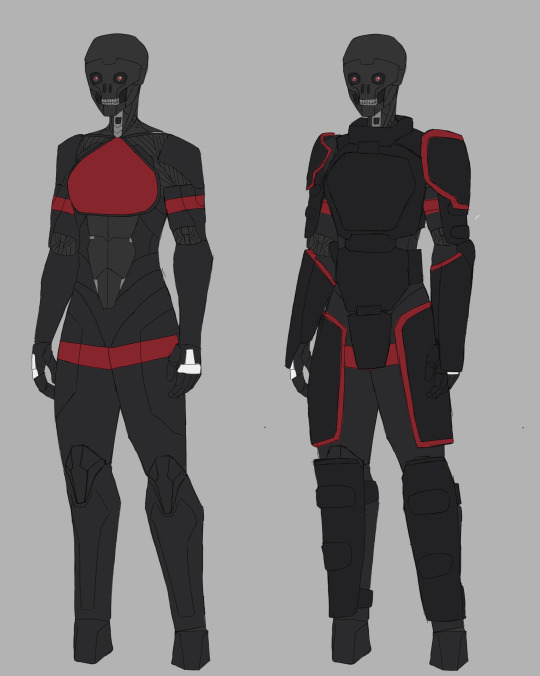



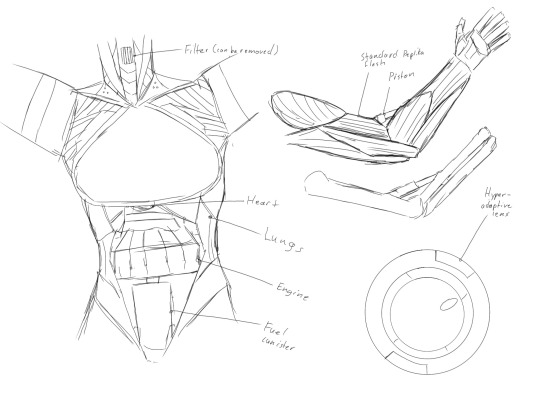

SKUR
Schwere-Kommando-Ungeheuer-Replika
Heavy-commando-Behemoth-Replica
Großer Skuas, or Schwere-Kampf-ungeheuer-Replikas, “Great Skuas”, often simply referred to as Skuas, are heavy commandos utilized by the nation in dangerous raids. These units are large and bulky, wearing heavy armor and welding weapons that are usually too heavy not to be on a mount. They operate in small groups, usually one to three, commanded by a KLBR, STAR, LSTR, STCR unit, or with an infantry force.
Skuas use a wide variety of heavy weapons, from machine guns and grenade launchers to flamethrowers and shotguns. Whatever the weapon, they’re always hyper-powered and usually too heavy for most units to even carry, much less use. They can unmount vehicle machine guns and use them in a man-portable fashion. Their armor is strong enough to block shotgun rounds at point blank range. Despite their large, heavy appearance, Skuas are deceptively fast. They carry cargos of ammunition and gear, and can be used as workhorses for transport.
Skuas are the perfect soldier in a way that an angel is the perfect human. They’ve been stripped from their humanity in a barbaric defiance of the natural order of creation, leaving an abomination whose sole purpose is bringing death in the most destructive manner possible. They feature skinless, fleshless, skull-like-heads, and many of their internal organs have been replaced with mechanics. They have no stomach and run instead on pressurized gasolines, and can create improvised fuels from processing and liquidizing organic matter, allowing them to attain fuel in the field and go without supplies for close to years. They can go without fuel for up to a week, and their fuel-processing systems allow them to live on diets of wood and even flesh. Their internal fuel systems and generators are located where their stomach and other organs used to be. Connected to the fuel system and remaining heart and lungs is a sophisticated engine that emits a low whir or hum. With no lips, their voicebox is located directly in the back of the throat, and sounds more mechanical than a normal replika. Their voice tends to be unsettling, like it’s not real or that it cuts through one’s ears. They will often cough the exhaust from their internal engine systems.
Skuas do not feel pain, and will instead feel a dull pressure when damaged, only so that they’re aware of their wounds. They must be watched closely as they see no difference between a pinprick and decapitation. They feature air filters in the neck and are immune to toxins, and can breathe even through even the thickest smoke and dust. Advanced cooling and ventilation control systems allow them to survive in both extremely hot or cold environments. Their joints are more mechanical, mixing machine pistons with their pseudo-flesh to strengthen them. Their cranial construction and nervous system are organic and interconnected with their machine structures and systems. They lack conventional eidetic modules and utilize instead camera-like lenses that are more immune to flash-grenades and cannot be blinded by debris. A built-in decibel limit also prevents becoming deaf, temporarily or otherwise. Arteries and veins are seamlessly integrated with the other mechanical systems. Though they possess no stomach, intestines, liver, kidneys, and other artificial internal organs that replikas typically have, they still have their heart, blood, and lungs to pump oxygen into the fuel systems.
Skuas operate well alone and in groups. One can be sent on a near-suicidal operation or can serve as support for a larger infantry.
Skuas are generally led by a handler, usually an Elster, Kolibri, Storch, or Starling unit. Each handler type fulfills a different role. Elster units lead Skuas far into unsurveyed enemy territory with little information and even less support. Storch-led Skuas operate raids. Starlings lead Skuas among other infantry, and Kolibris will operate a wider variety of roles in-high-stakes operations. Roles may vary, such as Elster units leading a defense campaign or a Starling leading a raid.
The commanding handler of Skua units must be evaluated for loyalty, as Skuas are easy to manipulate due to their unwavering, unquestioning, and extreme obedience. Commanding officers’ sole role is to manage the commandos, dealing with maintenance and orders. While not higher ranking than other officers, having the deadly and intimidating behemoths under their command affords handlers an uncanny authority. Skuas will develop close bonds with their commander, and are extremely protective of them.
Due to their skinless, faceless nature, Skuas are difficult at best to read. It is hard to gauge their emotions by their voice, which itself is monotone and formal, and their demeanor is similarly difficult to gauge. Their commanding handlers are expected to understand the subtle signs that signify their mental state, such as a clenched jaw in anger, and the activation of ventilation systems located in the neck and spine when flustered. Skuas do not possess tear nor mucus ducts, and will emit sporadic growls and hums instead of crying. Similarly, harder, louder, more aggressive growls can be heard if the Skua is particularly angry. When especially happy or content, they will produce deeper, louder humming sounds akin to purrs. Skuas also lack sweat glands, using their internal cooling and ventilation systems to stay at optimal temperature. Oddly, a byproduct of their unorthodox nerve system is that they enjoy being pet. Handlers discover a ‘sweet spot’, usually located on the torso.
Skua personalities appear dull and empty. They speak in monotone voices and tend to be very passive. In combat, they are aggressive and destructive, yet calm, causing maximum damage in minimal time. They fight in an oppressive fashion, fighting in such a manner that enemy combatants hardly have a chance to fire back. Unlike other combat units, they show no affinity nor fondness for violence, it’s simply a task that must be done. Skuas are wholly and entirely obedient to commanding units, utterly unquestioning of the even most appalling orders. While deep down, a sense of morality can theoretically be found, said ethics are completely ignored when an order contradicts what little there is. They will not go out of the way to cause maximum collateral, but have no qualms about it. For these reasons, Skaus can also function as executors. Their obedience makes them easy to manipulate, and are generally under the command of a replika instead of a gestalt. Upon further interaction, Skuas will reveal a calm and soft personality, akin to MNHR type units. When interacting with other units, they will minimize movement, as they do not know their own strength and can cause injury. They tend to not speak, aware of the intrinsic unsettling quality of their voice.
Skuas are physically terrifying to most units. Faceless, monstrous, destructive, and smelling of exhaust, they’re avoided almost entirely. They serve as omens to mass destruction to the enemy. Skuas themselves have no particular fondness for specific units. If any treats them as more than a demonic tool, they will attempt to befriend the person. Showing affection to the unloved units is an effective and easy way to gain their trust. Underneath their corpse-like and violent exterior, Skuas are gentle souls. They are fascinated by gestalts and their lives, as well as other replikas, and display a childlike curiosity with the world. They stabilize their persona by drawing and sketching. They may tattoo each other’s armor so that others can tell them apart, usually drawing little more than numbers. Often, one can find Skaus hidden just off the area where Eules work, as they listen to their singing and music. They enjoy looking for flowers when off duty, and will decorate each other with them.
Naming conventions are random. They have no preference for names and are generally named by their commanding officer, sometimes others, very rarely themselves. More personalized names stem from commanders. More generic names will come from nearby compatriots.
While technically female, Skuas are often referred to as “it” by others, not afforded the luxury of humanization. They make no movements to correct the notion. They are seen as unmanned combat vehicles rather than replikas, and they know it. Handlers are to refer to them more humanely, and are to provide names if a unit doesn’t have one.
The gestalt template for the Skua unit was a gunner in an aircraft crew, chosen for their keen eye, unyielding loyalty, and will of steel. Skuas are to be kept on-ground purely as foot soldiers to minimize resurfacing memories. Degraded Skuas are extremely dysphoric and must never look into a mirror. When degraded, Skuas remain mostly obedient but erratic and confused. They become unsteady on their feet and will attempt to board aircraft. Obedience will not decline, but they will question unfamiliar commanders. Late-stage degradation will reveals mania and violence. Decommission degrading Skuas immediately as soon as degradation is confirmed. They can easily be disposed of by having their handler disarm them, though convincing their handler to do so may be difficult. Use anti-armor rounds for a quick operation.
#If I’ve seemed less active it’s because I was working on this chucklefuck#Obsessing over her so mich#Almost 8 foot tall behemoth listening to tiny kopipi:#Fun dynamics and fun stuff planned#skua#skua signalis#Signalis oc#signalis fanart#my art#signalis#jay art
45 notes
·
View notes
Text
explaining f1: the cars
chassis
modern day f1 cars are constructed from composites of carbon fibre and other ultra-lightweight materials. the minimum weight currently permissible is 740kg including the driver but not the fuel.
engines
as of the 2014 season, all f1 cars have been equipped with turbocharged 1.6 l v6 engines, which were previously banned in 1989. this change gave up to a 29% increase in fuel efficiency.
transmission
f1 cars use highly automated semi-automatic sequential gearboxes, with regulations stating that 8 forward gears and 1 reverse gear must be used, with rear-wheel drive. fully automatic gearboxes are illegal to keep driver skill. the last f1 car fitted with a conventional manual gearbox was the forti fg01 which raced in 1995.
as of 2009, all teams use seamless-shift transmissions, which allow a near instantaneous changing of gears for minimal time loss. shift times for modern f1 cars are in the range of 2-3ms.
steering wheel
the wheel can be used to change gears, adjust the fuel/air mix, change the break balance and call the radio among other things, allowing the driver a huge amount of control. data such as engine rpm, lap times and tyre temperature etc. are displayed.
fuel
the fuel in f1 cars is fairly similar to ordinary petrol.
to make sure teams and fuel suppliers are within regulation, the fia requires fuel teams like shell, petronas etc. to submit samples of the fuels they are providing for races. at any time, fia inspectors can request a sample from the fuelling rig to compare. the teams usually abide by rules but in 1997 mika hakkinen was stripped of his third place finish in spa due to his fuel being the incorrect formula.
tyres
you can read all about tyres in f1 here!
breaks
the brakes used in f1 cars are designed to work in up to 1,000 degrees celsius.
drivers can control brake force to compensate for changes in track condition or fuel load.
notable cars
the victorious red bull racing rb18 from the 2022 season, driven by max verstappen.
the dominant mclaren mp4/4 driven by ayrton senna in 1988.
the highly successful ferrari f2004 driven by micheal schumacher at the 2004 united states grand prix.
the 1994 williams fw15c, widely considered to be one of the most technologically advanced f1 car of all time
the first f1 car to be powered by a turbocharged engine; the 1997 renault rs01.
the lotus 78, which exploited the aerodynamic effects of downforce, or ground effect, which was banned by the fia in 1983 (though it was later brought back for the 2022 season onwards).
the 2009 brawn bgp001, using a 'double diffuser' (to harness downforce) which was banned by the fia in 2011.
#f1#alex albon#carlos sainz#charles leclerc#fernando alonso#formula one#george russell#lance stroll#lando norris#lewis hamilton#formula 1#f1 2024#imola 2024#imolagp#italy 2024#logan sargeant#oscar piastri#sebastian vettel#jenson button#kimi raikkonen#kimi räikkönen#mercedes f1#ferrari#mclaren#aston martin#mark webber
132 notes
·
View notes
Text
✨️Friendship Among the Stars✨️
These two OC's are my favorites so much so that they are the two units I designed an entire story for now
👾Alien: Luna
⭐️Hybrid: Mika
If there was a song that represented their vibe, I would choose this one
If you like reading I hope you like what I wrote (it was a story when I was 17 so it was my first attempt at that time)

In a small village on the outskirts of the city, where nature and technology intertwined, Mika spent most of her time helping her grandfather in his unusual barn. But this wasn’t an ordinary barn—it was home to robotic animals, creations of her grandfather’s genius. Mika loved working there, finding joy in fixing and improving these mechanical creatures.
One day, her grandfather sent her to fetch some tools from an old storage shed near the hills. Carrying a toolbox, she walked across the fields when a strange buzzing sound filled the air, followed by a sudden flash of blue light. Looking up, she saw what appeared to be a small meteor streaking down before landing—surprisingly gently—in an abandoned field next to the barn.
Curiosity got the best of her. Mika sprinted toward the site, only to find a strange, dust-covered spacecraft emitting smoke. It looked like it had made an emergency landing. She hesitated for a moment, then cautiously stepped closer, reaching out to touch its cool metallic surface. Just then, a faint sound came from inside.
She quickly stepped back as the spacecraft’s hatch slowly opened. From within, a girl emerged—her skin a deep shade of violet, her glowing eyes scanning the surroundings warily. Small antennae adorned her head, along with sleek digital-looking hair accessories.
"Who... are you?" Mika asked, staring in astonishment.
The girl hesitated, as if unsure whether to trust Mika, before finally speaking in a soft voice.
"My name is Luna... and I need help."
Despite the shock, Mika felt no fear. Instead, a strange excitement bubbled within her. She had always felt different from those around her, and now, standing before her, was someone who seemed just as out of place in this world as she was.
With a confident smile, Mika extended her hand and said,
"Well, Luna… welcome to Earth!"

👾⭐️Background: Luna – The Runaway Princess
Far beyond Earth, deep in the cosmic expanse, lay the planet Velmara—a world of towering crystalline cities, floating islands, and an advanced civilization that thrived on technology and strict order. Among its rulers was Queen Xyara, a powerful and unyielding monarch who sought to expand her empire through control and precision.
Born into the royal family, Luna was expected to follow in her mother’s footsteps, inheriting the throne and continuing the Velmarian legacy. However, Luna was different. Unlike her mother and the council, who valued authority above all else, Luna was curious, rebellious, and drawn to the unknown. She spent her days sneaking into the archives, learning about distant planets, and questioning the rigid laws that bound her people.
Her curiosity was seen as a flaw, a sign of weakness. The more she questioned, the more her mother tightened her grip, forcing her into endless training sessions to mold her into the perfect heir. But Luna longed for freedom—to see the universe beyond her mother’s reach.
One fateful night, after overhearing a conversation about an arranged political alliance that would strip her of any remaining autonomy, Luna made her decision. Using her knowledge of Velmarian engineering, she stole a small exploration craft, programming it to take her as far from Velmara as possible. However, something went wrong during her escape—the ship’s navigation system malfunctioned, and she crash-landed on an unfamiliar blue planet: Earth
I designed Luna's little sister once, although I didn't really like her design

Thanks for reading
I hope you enjoyed it🩷

#digital artist#my art#digital art#artwork#art#artists on tumblr#oc artist#story#my ocs#my persona#my writing#chibi girl#my post#furry#furry art#furry oc#furry fandom#alien girl#my art <3#my artwork#oc sketch#original character#original art#ocs#oc art#writing#my writes#young artist#digital illustration#digital drawing
22 notes
·
View notes
Text


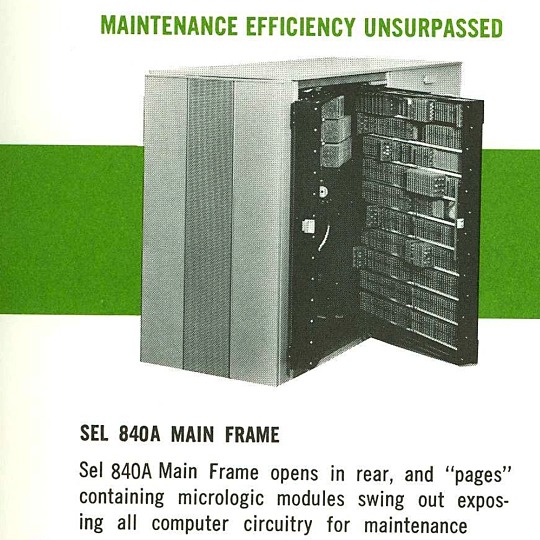
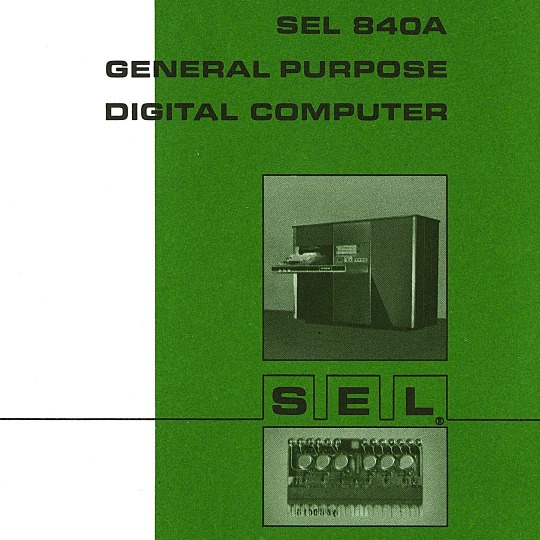
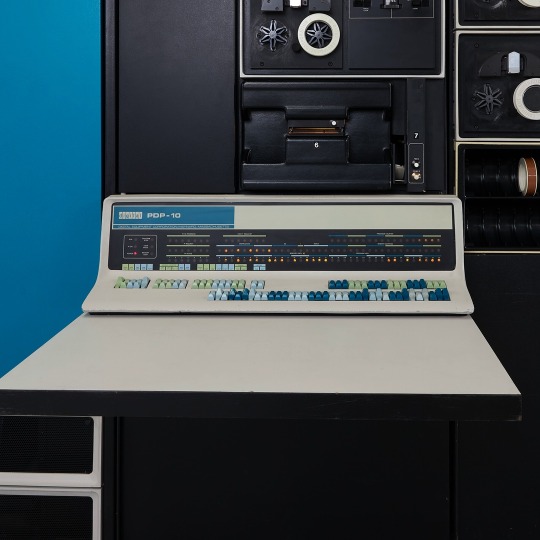

🎄💾🗓️ Day 11: Retrocomputing Advent Calendar - The SEL 840A🎄💾🗓️
Systems Engineering Laboratories (SEL) introduced the SEL 840A in 1965. This is a deep cut folks, buckle in. It was designed as a high-performance, 24-bit general-purpose digital computer, particularly well-suited for scientific and industrial real-time applications.
Notable for using silicon monolithic integrated circuits and a modular architecture. Supported advanced computation with features like concurrent floating-point arithmetic via an optional Extended Arithmetic Unit (EAU), which allowed independent arithmetic processing in single or double precision. With a core memory cycle time of 1.75 microseconds and a capacity of up to 32,768 directly addressable words, the SEL 840A had impressive computational speed and versatility for its time.
Its instruction set covered arithmetic operations, branching, and program control. The computer had fairly robust I/O capabilities, supporting up to 128 input/output units and optional block transfer control for high-speed data movement. SEL 840A had real-time applications, such as data acquisition, industrial automation, and control systems, with features like multi-level priority interrupts and a real-time clock with millisecond resolution.
Software support included a FORTRAN IV compiler, mnemonic assembler, and a library of scientific subroutines, making it accessible for scientific and engineering use. The operator’s console provided immediate access to registers, control functions, and user interaction! Designed to be maintained, its modular design had serviceability you do often not see today, with swing-out circuit pages and accessible test points.
And here's a personal… personal computer history from Adafruit team member, Dan…
== The first computer I used was an SEL-840A, PDF:
I learned Fortran on it in eight grade, in 1970. It was at Oak Ridge National Laboratory, where my parents worked, and was used to take data from cyclotron experiments and perform calculations. I later patched the Fortran compiler on it to take single-quoted strings, like 'HELLO', in Fortran FORMAT statements, instead of having to use Hollerith counts, like 5HHELLO.
In 1971-1972, in high school, I used a PDP-10 (model KA10) timesharing system, run by BOCES LIRICS on Long Island, NY, while we were there for one year on an exchange.
This is the front panel of the actual computer I used. I worked at the computer center in the summer. I know the fellow in the picture: he was an older high school student at the time.
The first "personal" computers I used were Xerox Alto, Xerox Dorado, Xerox Dandelion (Xerox Star 8010), Apple Lisa, and Apple Mac, and an original IBM PC. Later I used DEC VAXstations.
Dan kinda wins the first computer contest if there was one… Have first computer memories? Post’em up in the comments, or post yours on socialz’ and tag them #firstcomputer #retrocomputing – See you back here tomorrow!
#retrocomputing#firstcomputer#electronics#sel840a#1960scomputers#fortran#computinghistory#vintagecomputing#realtimecomputing#industrialautomation#siliconcircuits#modulararchitecture#floatingpointarithmetic#computerscience#fortrancode#corememory#oakridgenationallab#cyclotron#pdp10#xeroxalto#computermuseum#historyofcomputing#classiccomputing#nostalgictech#selcomputers#scientificcomputing#digitalhistory#engineeringmarvel#techthroughdecades#console
31 notes
·
View notes
Text
Sleepers Were Never Meant For Labor
Sleepers can't be THAT efficient. Not more efficient than regular robots on factory lines or more advanced futuristic drones. They're practically a money pit, if you ask me. 1 out of 10 Sleepers escape...lets say every year. Given the intuited size of Essen-Arp and all its locations (factories, mining colonies, refineries) where Sleepers are working...let's be charitable and say that two-hundred Sleepers escape every year. These Sleepers would also take Stabilizer with them, or find a way to source it on the outside, so that's stock of Stabilizer going missing and out of Essen-Arp's hands. Not only that, but then they have to spend more resources sending Hunters down after them. Essen-Arp created a whole new class of Sleepers just to perform as Hunters and nothing else.
Now consider this - during Sabine's questline in Citizen Sleeper 1, what do we learn what Essen-Arp is most known for? Bionics. Bio-synthetic medicines, and other such augments. That's what they copyright, that's what they produce and develop, that's their main export, THEIR market share. Why would they get into the business of Slavery all the sudden with a fledgling android program in the form of Sleepers?
I think Essen-Arp has a larger end goal here, they're working toward a...Final Solution, if you'll pardon the comparison.
Are you perhaps familiar with Warhammer 40k's Adeptus Mechanicus? The "Machine Cult" as they're often referred to. You don't need to know the specifics, but they're fanatical transhumanists who aspire to the "purity of the blessed Machine" they worship a Machine God, and its prophet called the "Omnissiah". They forsake their flesh with reckless abandon, replacing parts with superior augmetics.
Now consider: Sleeper frames are objectively superior to human bodies. Even with their "planned obsolescence" and constant degradation. That's just a prototype, it'll be patched out in later models. Sleeper frames can go days without eating a damn thing. They don't need to breathe. They're immune to disease. They need no water. They produce no waste. They can work in extreme and hostile environments that humans would need extensive protection to even go into. They can interface with machines in precise and unique ways. Multiple characters remark throughout both games that Sleepers can work longer and harder than humans with a more consistent output, and these are just Sleepers who have been on the run. Who have been running on fumes and spite for their creators; Imagine what a Sleeper in its prime could accomplish...
Sleeper technology is in its infancy. Unable to be fully exploited for its full worth. All the Sleepers that exist in the setting today are prototypes, test subjects, control units. There are legions of Essen-Arp scientists and engineers observing them, testing them constantly logging data, tweaking formulas, adjusting designs for the eventual Perfect Sleeper so that only the most wealthy and powerful could upload their minds into, and become Gods in the Machine
Anyway, theory over
20 notes
·
View notes
Text

Cyclops
The Cyclops began production in 2710 as an assault BattleMech and headquarters unit for Star League Defense Force field commanders. A decent mix of weapons provided the Cyclops with both long- and short-range firepower and a sizable engine to keep up with mobile operations. The most important feature of the 'Mech though was its advanced electronics, especially the Tacticon B-2000 Battle Computer, which allows the pilot to effectively command up to brigade-sized units. Other aspects of the 'Mech are less than stellar however. The diverse array of weapons means the 'Mech does suffer somewhat from ammunition issues while meager armoring provides less protection than that found on similar machines, though it is enough to stave off attackers until reinforcements arrive. In particular the armoring on the head section, while as heavily protected as allowed by the internal structure, leaves the pilot and the sophisticated command and control equipment more vulnerable than usual. When operating as the command vehicle at regimental and higher echelons with an ample support apparatus and guarded by a headquarters lance, these deficiencies are far less noticeable and the Cyclops could be kept in reserve until employed to turn the tide of battle or exploit a weakness.
Unfortunately the Cyclops did not fare so well with the onset of the Amaris Civil War when the Rim Worlds Republic Military destroyed its primary factory on Caph in 2774. Spare parts for the machine quickly began to dry up, until by the end of the Succession Wars less than ten percent still had a working B-2000 computer. Lacking the critical part of being a command vehicle many Cyclopses were pressed into an assault role. Acting as the bodyguard or decoy for the real commanding officer, they proved to be swift if mediocre combat machines. As most enemies know about the vulnerable head and automatically target it in combat, many Cyclops pilots also began adding false head protectors to defend against impacts. A study by the NAIS after the Fourth Succession War would eventually find that these caused more harm than good by restricting vision and increasing shrapnel, ending the practice altogether.
The rediscovery of the Helm Memory Core kick-started a number of attempts to replicate the B-2000 computer, however there were no successful attempts prior to the Clan Invasion. Also, the invention of the C3 computer with its emphasis on small-scale networking, and a switch in doctrine to using DropShips as command posts, saw the Cyclops' command role decline. However Grumium Creations was eventually able to restart production of new variants of the 'Mech, and where it has participated a Cyclops with a working B-2000 has had noticeable effects. For this reason Cyclops 'Mechs with a working battle computer were reserved for high-ranking officers.
The Cyclops carries an arsenal built to handle almost any situation. For long-range combat and indirect fire, the 'Mech carries a Delta Dart LRM-10 missile launcher in the left torso along with one ton of reloads. For closer ranges the 'Mech has a variety of weapons. A Zeus-36, Mark III Autocannon/20 mounted in the right torso keeps all but the heaviest 'Mechs at a respectable distance and is fed by four tons of ammo split between the side torsos. The autocannon is backed up by two Diverse Optics Type 20 medium lasers, one in either arm, and a Hovertec Quad SRM-4 with one ton of reloads in the center torso.
The centerpiece of the Cyclops is its sophisticated holographic battle computer, the Tacticon B-2000. When combined with the Olmstead 840 tight beam comm suite with SatNav module, the Cyclops can effectively command a brigade across the surface of an entire world. Unfortunately the Cyclops is poorly protected relative to other assault 'Mechs with only ten tons of armor, and while its normal load of twelve heat sinks allows it to stay cool in most cases, they can prove to be inadequate in especially heavy situations.
21 notes
·
View notes
Text

(zoom in!)
Two double-headers on the Trans-Gooiw Railroad passing each other in the hills, dragging long freight trains behind them, during the early days of the Pan-Mellanus Oil Crisis.
More mellanoid trains: Guz's Model Garratt | Museum-piece carrying rocket parts | Advanced Steam Tank Engine | Guz's bigger model Garratt | Tram and Coal Mine loco sketches.
The diesel-hydraulic at the front of the foreground consist, already somewhat old and tired by this point, dates back to around the time period that steam engines were originally retired on Mellanus. It's not very fuel efficient as it is, and with the oil rations, diesels can not handle the trains on their own any longer.
For a few years now the railroads have been taking their steam engines out of mothballs and museums, as coal was comparatively dirt-cheap. Still though, the various maintenance and operational complexities of running steam locomotives resulted in a lot of losses for the railroads.
Pictured here behind the diesel is an early attempt at the Advanced Steam Engine concept, modifying a member of a very prolific and successful 2-8-0+0-8-2 Garratt class with a gas producer combustion system, more modern cylinders and valve gear, and entirely replacing the cab with an electronic control system (with the more diesel-like control stands moved to separate cabs on the tenders). The electronic control scheme allows for the steam engine to be connected to a diesel engine to be run as a multiple unit, cutting down operational costs. However, as a modified prototype, this locomotive lacks some of the other features which exemplified the Advanced Steam era, such as modular ashpans, computerized control, and precision engineering.
On the other track, moving the opposite direction, we see a double header of two steam locomotives, another 2-8-0+0-8-2 loaned from the Slaibsgloth Coal Mine Railroad, and a 2-10-2 'easy' type non-articulated loco leads the train. In this case, there is no electronic connection, so a crew of four mellanoid slimes is necessary to operate the train.
The eagle-eyed railway fans will notice that there are radiators for a dynamic brake on the diesel, yet the diesel is an electric. Diesel-electric dynamic brakes switch the traction motors into generators, and dump the electricity out as waste heat--but there's no traction motors on a hydraulic. So why the radiator fins? There's still a dynamic engine brake on the diesel-hydraulic, so it still needs to be able to dissipate heat, especially on the mountain routes.
WIP images follow:
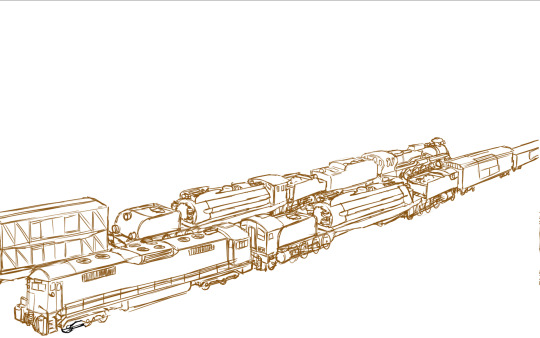


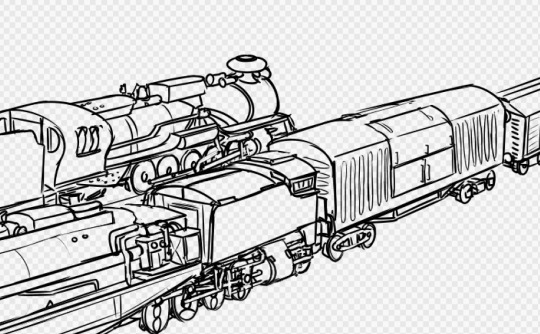
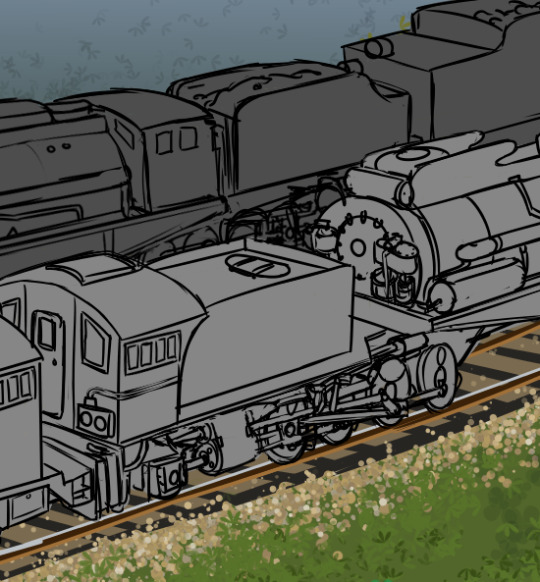

#Steam locomotive#steam engine#steam train#train#worldbuilding#mellanoid slime#railroad#diesel locomotive#road-switcher#diesel-hydraulic#locomotive#locomotive design#Garratt#Beyer-Garratt#articulated locomotive#Slime Trains#trains
94 notes
·
View notes
Text
For a while in the mid-2000s, a refrigerator-sized box in Abu Dhabi was considered the greatest chess player in the world. Its name was Hydra, and it was a small super-computer—a cabinet full of industrial-grade processors and specially designed chips, strung together with fiber-optic cables and jacked into the internet.
At a time when chess was still the main gladiatorial arena for competition between humans and AI, Hydra and its exploits were briefly the stuff of legend. The New Yorker published a contemplative 5,000-word feature about its emergent creativity; WIRED declared Hydra “fearsome”; and chess publications covered its victories with the violence of wrestling commentary. Hydra, they wrote, was a “monster machine” that “slowly strangled” human grand masters.
True to form as a monster, Hydra was also isolated and strange. Other advanced chess engines at the time—Hydra’s rivals—ran on ordinary PCs and were available for anyone to download. But the full power of Hydra’s 32-processor cluster could be used by only one person at a time. And by the summer of 2005, even the members of Hydra’s development team were struggling to get a turn with their creation.
That’s because the team’s patron—the then 36-year-old Emirati man who’d hired them and put up the money for Hydra’s souped-up hardware—was too busy reaping his reward. On an online chess forum in 2005, Hydra’s Austrian chief architect, Chrilly Donninger, described this benefactor as the greatest “computer chess freak” alive. “The sponsor,” he wrote, “loves to play day and night with Hydra.”
Under the username zor_champ, the Emirati sponsor would log in to online chess tournaments and, with Hydra, play as a human-computer team. More often than not, they would trounce the competition. “He loved the power of man plus machine,” one engineer told me. “He loved to win.”
Hydra eventually got overtaken by other chess computers and was discontinued in the late 2000s. But zor_champ went on to become one of the most powerful, least understood men in the world. His real name is Sheikh Tahnoun bin Zayed al Nahyan.
A bearded, wiry figure who’s almost never seen without dark sunglasses, Tahnoun is the United Arab Emirates’ national security adviser—the intelligence chief to one of the world’s wealthiest and most surveillance-happy small nations. He’s also the younger brother of the country’s hereditary, autocratic president, Mohamed bin Zayed al Nahyan. But perhaps most important, and most bizarrely for a spymaster, Tahnoun wields official control over much of Abu Dhabi’s vast sovereign wealth. Bloomberg News reported last year that he directly oversees a $1.5 trillion empire—more cash than just about anyone on the planet.
In his personal style, Tahnoun comes across as one-third Gulf royal, one-third fitness-obsessed tech founder, and one-third Bond villain. Among his many, many business interests, he presides over a sprawling tech conglomerate called G42 (a reference to the book The Hitchhiker’s Guide to the Galaxy, in which “42” is a super-computer’s answer to the question of “life, the universe, and everything”). G42 has a hand in everything from AI research to biotechnology—with special areas of strength in state-sponsored hacking and surveillance tech. Tahnoun is fanatical about Brazilian jiujitsu and cycling. He wears his sunglasses even at the gym because of a sensitivity to light, and he surrounds himself with UFC champions and mixed martial arts fighters.
According to a businessman and a security consultant who’ve met with Tahnoun, visitors who make it past his layers of loyal gatekeepers might get a chance to speak with him only after cycling laps with the sheikh around his private velodrome. He has been known to spend hours in a flotation chamber, the consultant says, and has flown health guru Peter Attia into the UAE to offer guidance on longevity. According to a businessman who was present for the discussion, Tahnoun even inspired Mohammed bin Salman, Saudi Arabia’s powerful crown prince, to cut back on fast food and join him in a quest to live to 150.
But in recent years, a new quest has taken up much of Sheikh Tahnoun’s attention. His onetime chess and technology obsession has morphed into something far bigger: a hundred-billion-dollar campaign to turn Abu Dhabi into an AI superpower. And the teammate he’s set out to buy this time is the United States tech industry itself.
In the multiplayer game of strategy that is the AI arms race, the US controls the board right now for a pretty simple reason. A single American hardware company, Nvidia, makes the chips that train the most competitive AI models—and the US government has moved to restrict who can buy these Nvidia GPUs (as the chips are called) outside the country’s borders. To take advantage of this clear but jittery lead over China, the CEOs of America’s AI giants have fanned out across the globe to sweet-talk the world’s richest investors—people like Tahnoun—into financing what amounts to an enormous building boom.
Lurking behind every synthetic podcast and serving of AI slop is a huge, thrumming data center: Hundreds of Hydra-sized server cabinets lined up in tight rows, running computing processes that are tens or hundreds of times more energy-intensive than ordinary web searches. And behind those is another set of data centers that train foundational AI models. To keep pace with demand, AI companies need more data centers all over the world—plus the land to put them on, the water to cool them, the electricity to power them, and the microchips to run them. Nvidia CEO Jensen Huang has predicted that tech companies will pour a trillion dollars into new AI data centers over the next five years.
Building out the next phase of AI, in short, is set to require mind-boggling amounts of capital, real estate, and electricity—and the Gulf States, with their vast oil wealth and energy resources, possess all three. Saudi Arabia, Kuwait, and Qatar have all set up major AI investment funds in the past couple of years. But as a home for new data centers and a source of investment capital, the UAE has emerged as a particularly attractive potential partner on a number of fronts—from its sheer wealth to its brand-new nuclear power supply to the relative sophistication of its own AI sector.
But there’s a rub: Any American AI partnership with the UAE is, in some way, a relationship with Sheikh Tahnoun himself—and for years many of Tahnoun’s most important technology partners have been Chinese.
The pairing was only natural, given Tahnoun’s record as a spy chief with vast commercial interests in high-tech state control. Tahnoun spent the early 2020s forging deep business and personal ties with Beijing, to the point that some products sold by G42 came to be nearly indistinguishable from Chinese ones. A G42 subsidiary called Presight AI, for one, sold surveillance software to police forces worldwide that bore a close resemblance to systems used by Chinese law enforcement. The Chinese telecom giant Huawei’s footprints in G42 went even deeper. Early in the generative-AI boom, Huawei’s engineers moved freely through Abu Dhabi’s most sensitive tech facilities as they designed massive AI training centers.
But in August of 2023, Washington threw down a gauntlet. It restricted exports of Nvidia GPUs to the Middle East—the very hardware that Abu Dhabi needed to realize its own AI ambitions. No company using Huawei equipment would get access. So Tahnoun pivoted, hard. In early 2024, G42 announced it was severing ties with China and would rip out Chinese equipment. Chinese nationals began quietly departing Abu Dhabi’s tech sector.
At the same time, US and UAE leaders went into a fevered phase of mutual courtship. Scores of public relations consultants, lawyers, and Beltway lobbyists set about portraying Tahnoun as a safe pair of hands in which to place US technology and trust. Marty Edelman, the emirate’s most trusted American lawyer, helped orchestrate the strategy from New York. The UAE’s ambassador to Washington, Yousef Al Otaiba, deployed his considerable political capital to vouch for Tahnoun. Meanwhile, US government and tech leaders tried to maneuver what promised to be a huge spigot of Emirati money into the United States, to feed AI companies’ need for investment.
The first sign that the two sides had reached an understanding was, bizarrely, a deal that flowed in the opposite direction. In an unusual agreement brokered largely by officials in the Biden administration, Microsoft announced in April 2024 that it was investing $1.5 billion in Tahnoun’s G42, acquiring a minority stake in the company. According to remarks by a Biden official who helped steer the agreement, the objective was to get G42 to “work with Microsoft as an alternative to Huawei.” In the first phase of the relationship, G42 would gain access to Microsoft’s AI computing power on its Azure cloud platform, at a data center inside the UAE. And Brad Smith, Microsoft’s president, would join the board of G42—a kind of American chaperone inside the company.
The big gushers of cash from the UAE were still to come, as were any Nvidia chips for Abu Dhabi. But the Microsoft deal amounted to a US government seal of approval for further business with the Emirates. In the summer of 2024, Tahnoun embarked on a charm offensive across the United States, with a visit to Elon Musk in Texas and a jiujitsu session with Mark Zuckerberg. Meetups with Bill Gates, Satya Nadella, and Jeff Bezos followed in quick succession. The most important meetings, however, took place at the White House, with figures like national security adviser Jake Sullivan, Commerce secretary Gina Raimondo, and President Joe Biden himself.
As the frenzied campaign to reframe Tahnoun and G42’s image seemed to gain traction—and the US seemed poised to loosen export controls on advanced chips for the UAE—some inside the US national security establishment were, just as frantically, waving caution flags. One of their fears is that the intellectual property of the United States could still leak to China. “The Emiratis are the consummate hedgers,” a former senior US security official told me. “The question everyone has: Are they playing both sides?” In a July open letter, US congressman Michael McCaul, the chair of the House Foreign Affairs Committee, called for “significantly more robust national security guardrails” to be placed on the UAE before the US exported any sensitive technology to the country.
But the other fear is of the UAE itself—a country whose vision of using AI as a mechanism of state control is not all that different from Beijing’s. “The UAE is an authoritarian state with a dismal human rights record and a history of using technology to spy on activists, journalists, and dissidents,” says Eva Galperin, director of cybersecurity at the Electronic Frontier Foundation. “I don’t think there is any doubt that the UAE would like to influence the course of AI development”—in ways that are optimized not for democracy or any “shared human values,” but for police states.
This past summer, around the same time that Tahnoun was barnstorming through America’s dojos and C-suites, Mohammed bin Salman, the crown prince of Saudi Arabia, was hosting some of the world’s leading technology thinkers—including former Google CEO Eric Schmidt—at his vast South African hunting estate called Ekland. They visited game parks, were waited on by butlers, and discussed Saudi Arabia’s future role in AI.
Not long after, Schmidt made a trip to the Biden White House to air his concerns that the US cannot produce enough electricity to compete in AI. His suggestion? Closer financial and business ties with hydroelectric-rich Canada. “The alternative is to have the Arabs fund [AI],” he told a group of Stanford students on video the following week. “I like the Arabs personally … But they’re not going to adhere to our national security rules.”
Those concerns over the Gulf States’ reliability as allies (and their tendencies to engage in unsavory practices like targeting journalists and waging proxy wars) haven’t stopped their money from flowing into US tech companies. Earlier in the year, Saudi Arabia’s sovereign Public Investment Fund announced a $40 billion fund focused on AI investments, aided by a strategic partnership with the Silicon Valley venture capital firm Andreessen Horowitz. Kingdom Holding, an investment firm run by a Saudi royal who is deeply obedient to the crown prince, has also emerged as one of the biggest investors in Elon Musk’s startup xAI.
The New York Times wrote that the new Saudi fund made that country “the world’s largest investor in artificial intelligence.” But in September, the UAE eclipsed it: Abu Dhabi announced that a new AI investment vehicle called MGX would partner with BlackRock, Micro-soft, and Global Infrastructure Partners to pour more than $100 billion into, among other things, building a network of data centers and power plants across the United States. MGX—which is part of Tahnoun’s sovereign wealth portfolio—has also reportedly been in “early talks” with OpenAI CEO Sam Altman about what Altman hopes will be a 5 to 7 trillion-dollar moonshot chipmaking venture to create an alternative to Nvidia’s scarce GPUs.
The spigot of Emirati cash was now open. And in turn, within days of the MGX announcement, the news site Semafor reported that the US had cleared Nvidia to sell GPUs to G42. Some of the chips were already being deployed in Abu Dhabi, the news site reported, including “a sizable order of Nvidia H100 models.” The US had finally given Tahnoun some of the hardware he needed to build his next Hydra. Which raises the salience of two questions: What kind of game is Sheikh Tahnoun playing this time? And how exactly did he get control of so much wealth?
on some level, nearly every story about royalty in the Gulf is a story about succession—about paternalistic families trying to ward off external threats, and the internal rivalries that crop up when inherited power is up for grabs.
Tahnoun and his brother Mohamed are both sons of the UAE’s first president, Zayed bin Sultan al Nahyan—an iconic figure revered as the father of the nation.
For much of Zayed’s life, what is now the city of Abu Dhabi was an austere, seasonal fishing village with a harsh climate, a brackish water supply, and a nomadic population of about 2,000 people. The rest of the emirate had several thousand more Bedouin inhabitants. As rulers, the al Nahyans were paid in tributes and taxes, and served as custodians of the emirate’s shared resources. Their lifestyle wasn’t all that much better than that of their fellow tribesmen. But still it was dangerous at the top. Before Zayed, two of the last four sheikhs of Abu Dhabi had been assassinated by their brothers; another had been killed by a rival tribe.
Zayed, for his part, seized power from his older brother in a bloodless coup aided by the British in 1966—just as oil and its transformative wealth started flowing into Abu Dhabi. Where his elder sibling resisted spending Abu Dhabi’s new fortune, Zayed embraced modernization, development, and a vision for uniting several tribes under a single state—setting the stage for the creation of the United Arab Emirates in 1971.
When the UAE was formed, Tahnoun was almost 3 years old. A middle child among Zayed’s 20-odd sons, Tahnoun is one of the so-called Bani Fatima—the six male children of Zayed’s most favored wife, Fatima, and his most important heirs. Zayed groomed these sons to go abroad, become worldly, and take up the mantle of the UAE’s future. But even as he established a state that carefully distributed new oil wealth among Abu Dhabi’s Bedouins, Zayed steered his heirs away from business and self-enrichment. Perhaps mindful of the assassinations and coups that preceded him, Zayed wanted to ward off the perception that the al Nahyans were benefiting unfairly from their role as custodians of the country.
In the mid-1990s, Tahnoun found himself in Southern California. One day in 1995 he walked into a Brazilian jiujitsu dojo in San Diego, asking to be trained. He introduced himself as “Ben” and, according to an article on Brazilian Jiu-Jitsu Eastern Europe’s website, went out of his way to show humility, arriving early and helping to clean up. Only later did he reveal he was a prince of Abu Dhabi.
As Zayed’s health failed in the late 1990s, his sons began to step into bigger roles—and to break away from his guidance by starting businesses of their own. It was around this time that Tahnoun started his first holding company, the Royal Group, the entity he would use to incubate the Hydra chess computer. He also started a robotics company that produced a humanoid robot, REEM-C, which in turn was named after an island in Abu Dhabi where he made a series of real estate investments.
When Zayed died in 2004, Tahnoun’s eldest brother, Kha-lifa, became the new ruler of Abu Dhabi and president of the UAE, and Mohamed, the eldest of the Bani Fatima, became the crown prince. The other sons took on an array of official titles, but their roles were more ambiguous.
As a reporter based in Abu Dhabi from 2008 to 2011, I fell into the pastime of “sheikh watching,” a Gulf-royal version of Kremlinology that involves reading between the lines of announcements and moves, and keeping in touch with palace insiders who occasionally betray a few secrets. At the time, Tahnoun seemed like a fascinating dilettante very far from actual power—he held no serious role in the government and seemed preoccupied with growing his fortune, dabbling in technology, and changing the skyline of Abu Dhabi.
That all changed when Tahnoun stepped up as the family member with the greatest knack for wielding a growing tool for nation-states: cyberespionage.
In July 2009, thousands of BlackBerry users across the UAE noticed their phones growing dangerously hot. The culprit was a supposed “performance update” pushed by Etisalat, the UAE’s largest telecom provider. In reality, it was spyware—an early experiment in mass surveillance that backfired spectacularly when BlackBerry’s parent company exposed the scheme.
I experienced this myself one day on a trip from Abu Dhabi to Dubai, bringing my BlackBerry to my ear and finding it so hot it nearly burned my face. It was my first direct, personal experience of the UAE’s hidden police state. But shades of its existence are apparent to anyone who has spent time in the Gulf States. Violent crime is nearly nonexistent, and life can be smooth, even luxurious. But in moments of stress or risk, these countries can become very dangerous places, especially for residents who dare hint at dissent.
The revolutions of the Arab Spring in 2011—which saw four Middle Eastern autocrats topple in the face of massive, Twitter-organized crowds—only heightened the UAE’s resolve to stamp out any green shoots of democracy. When a handful of Emirati activists made their own mild case for human rights and political reform in 2011, the state convicted them on charges of royal defamation. Then it promptly pardoned and released them into a life of surveillance and harassment.
While there’s no evidence that Tahnoun had any direct involvement in the BlackBerry debacle, he would soon come to oversee an empire capable of far more sophisticated spycraft. In 2013, he was named deputy national security adviser—around which time the UAE’s ambitions to spy on its residents and enemies started to reach an industrial scale.
For several years at that point, the UAE had been running a secret program known as Project Raven, formed in 2008 under a contract with consultant and former US counterterrorism czar Richard Clarke. The US National Security Agency had blessed the arrangement, meant to give the UAE state-of-the-art surveillance and data analysis capabilities to contribute to the war on terror. But around 2014, Project Raven took a new tack. Under the new management of a US contractor called CyberPoint, it recruited dozens of former US intelligence operatives with a simple pitch: tax-free salaries, housing stipends, and a chance to fight terrorism.
But fighting terrorism was, in fact, only part of the agenda. Within two years, the project’s management changed hands yet again to a company called Dark-Matter, effectively an Emirati state-owned firm. Emirati intelligence leaders placed Project Raven under their own roof—just two floors from the UAE’s own version of the NSA. The message to Project Raven’s employees: Join DarkMatter or leave.
For those who remained, the job included tracking journalists, dissidents, and other perceived enemies of the state and the royal family. Among the key American operatives who stayed on with DarkMatter was Marc Baier, a veteran of the NSA’s elite Tailored Access Operations unit. Emails later showed Baier chatting with the Italian surveillance firm Hacking Team, describing his UAE clients as “the most senior” and demanding white-glove service as he shopped for hacking tools. Other former NSA hackers on the Project Raven team got busy developing custom attacks for specific devices and accounts.
They got to human rights activist Ahmed Mansoor—one of the Emiratis who had blogged in favor of democratic reform during the Arab Spring—through his child’s baby monitor. It was 2016, and Mansoor had grown used to his devices behaving strangely: phones that grew mysteriously hot, suspicious text messages, drained bank accounts, according to a person familiar with his experiences. His phone had even once been infected with Pegasus spyware, a notorious product made by the Israeli cyber-arms firm NSO Group. But the baby monitor was new. Unknown to him, operatives at DarkMatter were using it to listen to his family’s private conversations.
In another project, DarkMatter assembled what it called a “tiger team”—a task force to install mass-surveillance hardware in public places. These probes would be capable of “intercepting, modifying, and diverting” nearby traffic on UAE’s cellular networks, according to an Italian security researcher who was being courted by DarkMatter in 2016. “To operate as we want them to, these probes are going to be put everywhere,” the prospective hire, Simone Margaritelli, was told in an email during his recruitment process.
And who was ultimately overseeing all this activity? In early 2016, Tahnoun had been named national security adviser, which placed him fully in charge of UAE intelligence. And there are signs that the ultimate controlling party over DarkMatter was none other than Tahnoun’s investment firm, the Royal Group.
Eventually, I may have become a target of the UAE’s hacking apparatus myself. In 2021 a coalition of journalists called the Pegasus Project informed me that my phone had been targeted by the UAE using Pegasus spyware in 2018. At the time I’d been reporting on a global financial scandal that implicated a member of the Abu Dhabi royal family—Sheikh Tahnoun’s brother, Mansour. The UAE denied that it had targeted many of the people identified, including me.
The hacking and tracking of American citizens would eventually become a red line for some of Project Raven’s former intelligence agents. “I am working for a foreign intelligence agency who is targeting US persons,” a Project Raven whistleblower named Lori Stroud would tell Reuters in 2019. “I am officially the bad kind of spy.”
The ensuing scandal resulted in US federal charges for several of its ex-NSA leaders, including Baier. DarkMatter and Project Raven, meanwhile, were painstakingly broken down, scattered, rebranded, and then subsumed into other companies and government departments. Many of their pieces and personnel eventually moved under the umbrella of a single new entity founded in 2018—called G42.
G42 has denied publicly it had any connections to Dark-Matter, but the threads aren’t hard to see. One DarkMatter subsidiary, for instance, was an entity that worked especially closely with Chinese companies. Not only did it eventually appear to become part of G42, but the subsidiary’s CEO, Peng Xiao, went on to become the CEO of G42 itself.
A Chinese speaker who studied computer science at Hawaii Pacific University, Xiao’s past is otherwise a black box. Though he was a US citizen for a time, he eventually surrendered his US passport for UAE citizenship—an exceedingly rare honor for a non-Emirati. And under a subsidiary of G42 called Pax AI, Xiao helped produce the next evolutionary step in DarkMatter’s legacy.
One morning in 2019, millions of phones across the UAE lit up with a cheery notification. A new messaging app called ToTok promised what WhatsApp couldn’t—unrestricted calling in a country where the voice-calling function of most chat apps was blocked. Within weeks, it had shot to the top of Apple’s and Google’s app store even beyond the Emirates. But there was a catch. Each time someone tapped the app icon, the user gave the app access to everything on that phone—photos, messages, the camera, voice calls, location.
Data from millions of phones flowed to Pax AI. Like DarkMatter before it, Pax AI operated from the same building as the UAE’s intelligence agency. The ToTok app itself came from a collaboration with Chinese engineers. For a regime that had spent fortunes on NSO Group’s Pegasus spyware and DarkMatter’s hacking teams, ToTok was elegantly simple. People didn’t have to be laboriously targeted with spyware—they were eagerly downloading it.
Representatives of ToTok adamantly denied that their product was spyware, but an engineer who worked at G42 at the time told me that all of the voice, video, and text chats were analyzed by AI for what the government considered suspicious activity. (Among the easiest ways to get flagged: placing calls to Qatar, then a rival in a mutual cyberwar, from within the UAE.) G42 declined to comment on specific details for this story but responded to WIRED with an overall statement: “G42 is steadfast in its commitment to responsible innovation, ethical governance, and delivering transformative AI solutions globally.”
Inside G42, staff sometimes refer to Tahnoun as “Tiger,” and his orders can swiftly change the company’s course. One mandate from Tiger, according to a former engineer, was to build him either a business that generates $100 million in revenue a year or a technology that makes him famous. In the workplace, there is no mistaking that the conglomerate has one foot inside the security state: Most of the company’s technology and data centers are based in Zayed Military City, a restricted-access zone, and all G42 staff need to pass security clearances to get hired.
Through G42, government intelligence services, and other cybersecurity entities, Tahnoun had effectively come to oversee the UAE’s entire hacking apparatus. But at a certain point, control over the UAE’s spy sector and the industry around it wasn’t enough for Tahnoun.
By the turn of the decade, Tahnoun had ambitions for more political power over the whole of the Emirates. His sibling Mohamed had been serving as the de facto leader of the country since their brother President Kha-lifa suffered a major stroke in 2014. Now, as Khalifa’s health continued to fail and Mohamed’s formal accession to the throne was becoming imminent, the position of the next crown prince was up for grabs.
These moments of dynastic uncertainty can be dangerous. In Saudi Arabia, the sons of the country’s first king, Abdulaziz al-Saud, have taken the throne one after the other ever since the 1950s. By the time the current king, Salman, took power in 2015, he was 80 years old, and the ranks of potential heirs below him had become crowded, corrupt, and rife with internal tensions. That’s why, in 2017, King Salman’s son Mohammed, or MBS, struck out to eliminate his rivals—mostly cousins and their aides—by arresting them in a purge, asserting himself as the new strongman.
In Abu Dhabi, Tahnoun’s argument in the succession debate, according to royal insiders, was that his brother Mohamed should follow precedent and allow the sons of Zayed to rule while they were of good health and sound mind—a system that would place him in contention. But Mohamed was adamant that his own son Khalid should be crown prince, a signal to the country’s large youth population that they were represented high up in government.
Tahnoun argued his point for more than a year, even providing evidence that Mohamed’s plan contradicted their father’s request for succession. But in the end, the brothers worked out a deal. Tahnoun agreed to set aside his ambition to be the crown prince or ruler—in exchange for vast power over the country’s financial resources. It was this bargain that would ultimately put him in charge of $1.5 trillion in sovereign wealth.
In 2023, Tahnoun was made chairman of Abu Dhabi Investment Authority, the largest and most important sovereign wealth fund in the country. Khalid’s appointment as crown prince was announced weeks later.
Officially, Tahnoun got a modest bump in title to become deputy ruler along with his brother Hazza. But those dealing with Abu Dhabi over the past few years say the same thing: Tahnoun’s powers have increased by an extraordinary degree, and not just in finance. He has also taken over diplomacy with Iran, Qatar, and Israel, and even handled the United States for a time when relations with the Biden administration declined. “Whenever there’s a difficult file, it’s given to Tahnoun,” says Kristian Coates Ulrichsen, a scholar of Gulf politics at the Baker Institute for Public Policy at Rice University. That skill has helped him “grow his power enormously,” Ulrichsen says.
As Tahnoun has gained access to new resources, he has plowed them into his maze of investments and conglomerates. Under the Royal Group, he controls not only G42 but also another conglomerate called the International Holding Company—itself a massive consortium that employs more than 50,000 people and owns everything from a Zambian copper mine to the St. Regis golf club and island resort in Abu Dhabi. He also oversees First Abu Dhabi Bank, which is the UAE’s largest lender, and another multibillion-dollar sovereign wealth fund called ADQ.
And now, with a growing position in the global AI arms race, Tahnoun’s empire also includes a stake in the future of humanity.
In December, the US government confirmed it had authorized the export of some Nvidia GPUs to the UAE—specifically to a Microsoft-operated facility inside the country. At G42, subsidiaries have kept multi-plying: Space42 focuses on using AI to analyze satellite imaging data; Core42 aims to build massive AI data centers across Abu Dhabi’s deserts.
Inside the US security establishment, many remain worried about the US tech sector’s increasingly close relationship with the UAE. One unsettling fact, according to a former security official, was that China made no protest over Tahnoun’s decision to tear out all of Huawei’s equipment and sever ties with the company in 2023. “They didn’t raise a peep,” the official told me. When Sweden banned Chinese companies Huawei and ZTE from its 5G rollout in 2020, Beijing’s foreign ministry spoke out against it, and Swedish telecom giant Ericsson lost huge amounts of business in China in retaliation. By contrast, G42’s big breakup with China somehow got a pass—suggesting to the official that there may be some kind of backdoor understanding between the two nations.
In a statement to WIRED, US congressman Michael McCaul reiterated his concern that technology could leak to China through the UAE’s deal with Microsoft, and stressed the need for tighter guardrails. “Before advancing this partnership and others like it further, the US must first establish robust, legally binding protections that apply broadly to AI cooperation with the UAE,” he said.
But even if those guardrails were put into place, the UAE has a history of finding ways to do what it wants. I’m reminded of the briefings that executives from Israel’s NSO Group gave to journalists for a time in the early 2010s, assuring them that Pegasus spyware had safeguards against abuse—and that Pegasus clients (like the UAE) would be blocked from targeting US and UK phone numbers (like mine). And I’m reminded of the blessings that the NSA gave to Project Raven at its inception.
While Donald Trump and his new administration are expected to continue with export controls over GPU chips, the view from people inside Tahnoun’s orbit is that the new administration will likely be much more “flexible” about the UAE’s AI ambitions. Plus at least one Trumpworld insider has a vested interest in the relationship: The UAE, Qatar, and Saudi Arabia have together contributed more than $2 billion to Jared Kushner’s private equity fund, guaranteeing the fund some $20 million to $30 million in annual management fees alone. Abu Dhabi’s leaders have consulted with Kushner and other Trump insiders, including former secretary of state Mike Pompeo, on AI policy, according to people familiar with the discussions.
While the continued supply of GPUs could be a remaining source of leverage for the US, it could be a declining one as rival chips improve. Some analysts argue that, even now, export controls are not the source of strength that American officials think they are. “AI is not like nuclear power where you can restrict the materials,” says computer security expert Bruce Schneier. AI technology is already highly distributed, he says, and the idea that American companies are at a huge and absolute advantage is a mirage.
Now that Tahnoun has been “brought inside the tent”—and given a key and expanding role as an investor of choice for the current winners in the AI race—he has certainly succeeded in gaining some leverage of his own. And those who keep needing money from the UAE may be happy to see it gain more clout. At a World Government Summit last year, Sam Altman suggested that the UAE could even serve as the world’s “regulatory sandbox” for AI—a place where new rules for governing the technology can get written, tested, and advanced.
Meanwhile, the Middle East could be entering a period, like the aftermath of the Arab Spring, when rules are largely off the table. Now that rebels have taken over Syria from the regime of Bashar al Assad, the Gulf States—especially the UAE—will be anxious to increase surveillance to avoid any spread of Islamist unrest. “We’re going to see more repression, more use of surveillance technologies,” says Karen Young, a senior fellow at the Middle East Institute in Washington. And when it comes to managing threats and winning games of strategy, Tahnoun likes to make sure he’s playing with the most fearsome machine in the world.
20 notes
·
View notes